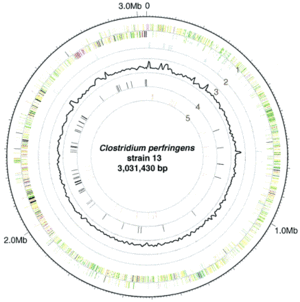Lactobacillus plantarum and its biological implications: Difference between revisions
No edit summary |
No edit summary |
||
| Line 21: | Line 21: | ||
==Section 1== | ==Section 1== | ||
<br>[[Image:genome.gif|thumb|300px|right| | <br>[[Image:genome.gif|thumb|300px|right|Genome-atlas view of the L. plantarum WCFS1 chromosome, with the predicted origin of replication at the top. The outer to inner circles show (i) positive strand ORFs (red); (ii) negative strand ORFs (blue); (iii) GC-skew (green); (iv) G+C content (black); (v) prophage-related functions (green) and IS-like elements (purple); and (vi) rDNA operons (black) and tRNA encoding genes (red). Kleerebezem 2003.]]Include some current research, with at least one figure showing data.<br> | ||
==Section 2== | ==Section 2== | ||
Revision as of 18:35, 22 April 2013
Introduction
By [Student Name]
At right is a sample image insertion. It works for any image uploaded anywhere to MicrobeWiki. The insertion code consists of:
Double brackets: [[
Filename: PHIL_1181_lores.jpg
Thumbnail status: |thumb|
Pixel size: |300px|
Placement on page: |right|
Legend/credit: Electron micrograph of the Ebola Zaire virus. This was the first photo ever taken of the virus, on 10/13/1976. By Dr. F.A. Murphy, now at U.C. Davis, then at the CDC.
Closed double brackets: ]]
Other examples:
Bold
Italic
Subscript: H2O
Superscript: Fe3+
Introduce the topic of your paper. What microorganisms are of interest? Habitat? Applications for medicine and/or environment?
Section 1

Include some current research, with at least one figure showing data.
Section 2
Include some current research, with at least one figure showing data.
Section 3
Include some current research, with at least one figure showing data.
Conclusion
Overall text length at least 3,000 words, with at least 3 figures.
References
Edited by student of Joan Slonczewski for BIOL 238 Microbiology, 2011, Kenyon College.

